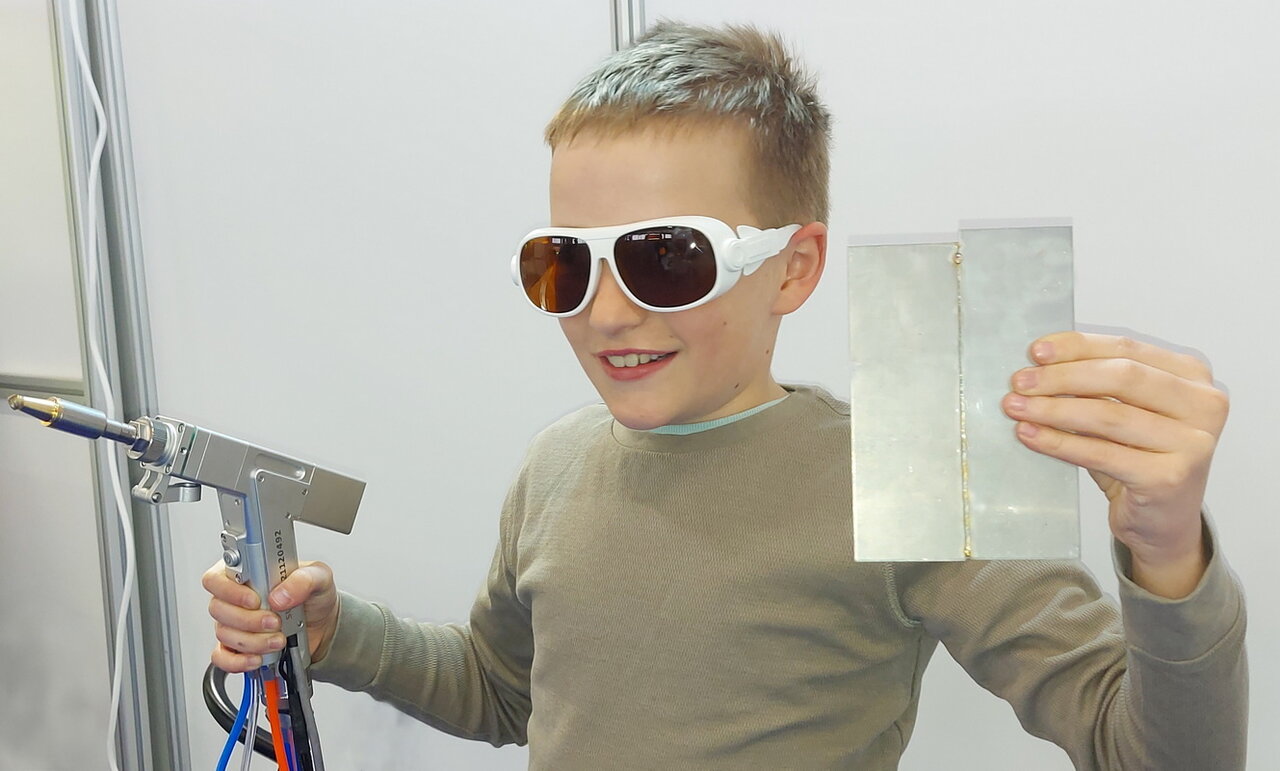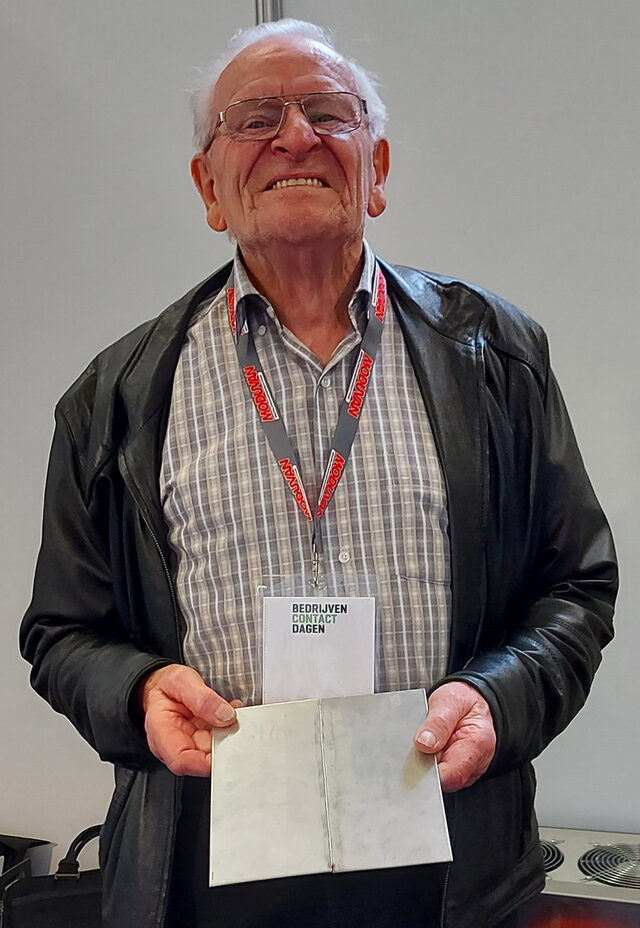
WHAT MAKES LASER WELDING SO ATTRACTIVE?
90% TIME SAVINGS*
65% COST SAVINGS*
* compared to manual MIG Welding
Everybody can laser Weld
Young - Old - Male - Female: everybody welds a quality weld within 10 minutes.

Why chosing for a laser Welding Machine?
Why to choose a laser welding machine?
They are very fast:
-
The laser allows the metal to be heated extremely quickly, while limiting the risk of deformation.
-
This technology is particularly effective for welding large quantities of sheet metal and is therefore widely used in the automotive industry.
They are also highly accurate:
-
They allow a localized, very fine, very clean, almost invisible welding.
-
They are particularly suitable for welding small parts.
-
This type of welding is very popular in the dental and jewellery industries as it provides the most aesthetic welding possible.
-
It is also possible to split the laser beam into several beams to provide welding that is even more accurate.
They can be adapted to a wide variety of part shapes and materials:
-
Laser welding machines are mainly used to weld metals, including refractory metals.
-
It is also possible to weld non-metallic parts with them, such as porcelain and glass.
-
You can use them to weld parts with very different shapes.
They do not wear out:
-
Laser welding machines operate without contact, so there is no risk of wear and tear on the machine.
-
There is also no need to change tools or electrodes, which is a definite advantage in terms of waste reduction.
They can be given orders digitally:
-
It is now possible to control the quality of the welding from a computer during the welding process.
-
The high level of automation allowed by such a process also makes it possible to detect and solve any quality problems.
They are VERY affordable
-
Fiber laser welding is now with our Lasermach WOBBLE Handheld fiber laser welding machine VERY affordable and accesable for every company
This is why all metal manufactouers switch to laser welding.
With laser welding they work faster, cleaner, without deformation and they earn much more money
Gas Metal Arc Welding (GMAW) vs Laser Welding
Gas Metal Arc Welding or MIG is a traditional technique using a consumable electrode that works well for larger, badly fitting parts.
-
Laser welding does not use consumable electrodes, requires less edge preparation, is easily automated and is up to 5x faster.
-
Lasers also provide more precision, and lower heat input.
Gas Tungsten Arc Welding (GTAW) vs Laser Welding
GTAW or TIG uses a non-consumable electrode and provides better process control than GMAW but any filler has to be added separately.
-
Lasers are up to 10x faster with higher precision, lower heat input, and are more easily automated.
Plasma Arc Welding (PAW) vs Laser Welding
Plasma Arc Welding is faster than Gas Tungsten Arc Welding, but much slower than laser welding. Having a large melt pool, PAW is good for badly aligned parts, but creates too much heat for many applications.
-
Lasers offer higher precision, are faster, and have lower heat input in a non-contact process.
-
Laser Wobble Welding is as effective on misaligned parts and does not require daily maintenance of the process head.
Resistance Spot Welding (RSW) vs Laser Welding
RSW is typically used for joining two pieces of material that are stacked on top of each other.
-
lasers only need single-side access, are much faster, and produce higher-strength welds.
-
Lasers do not require electrodes and eliminate the costs and time for electrode replacement.
Electron Beam Welding (EB) vs Laser Welding
Electron Beam welding provides excellent weld quality and a low heat affected zone. Because the process is in a vacuum chamber, contaminant levels are very low.
-
Laser welding speed is similar to electron beam, but because lasers do not require part transfer through a vacuum chamber, laser cycle time is dramatically shorter.
Why choose a PhotonWeld laser welding machine?
Laser welding machines have many advantages over traditional welding processes :
- Lasers provide contact-free, high-speed metal welding solutions for advanced manufacturing across countless industries. With fiber lasers, laser welding has become a highly reliable, easily automated process that provides the highest part quality, typically at the lowest processing costs, and virtually maintenance free.
- They are very fast: Laser Welding is much faster and more versatile than traditional welding methods. Laser energy provides consistent energy to the weld spot. This means excellent speed, thermal control, and seam quality. Voids and pockets are eliminated and secondary finishing is unnecessary.
- Minimal Heat Input: The laser allows the metal to be heated extremely quickly, while limiting the risk of deformation It reduces improper alterations to components. Less heat transfer to the surrounding metal also means less distortion at the weld seam. Also a much smaller HAZ (Heat Affected Zones) and much less crackings just beside the weld.
- They are highly accurate: They allow a localized, very fine, very clean, almost invisible welding with high precision. The laser beams can be easily controlled to weld the tiniest of parts without damaging them. They are particularly suitable for welding small parts, they are extremely accurate .
- They have a high consistency: It delivers consistent repeatability. One weld to the next can be virtually indistinguishable.
- They guarantee great strength: Laser Wobble welders do creates very high-strength welds.
- They can be adapted to a wide variety of part shapes and materials: You can use them to weld parts with very different shapes and to make complex Joints. It makes welding together materials that differ from each other possible.
- They do not wear out: Laser welding machines operate without contact, so there is no risk of wear and tear on the machine. There is also no need to change tools or electrodes, which is a definite advantage in terms of waste reduction. Pure and stable fiber laser source , 100,000 hours of lifetime, free of maintenance
- They are VERY Economical: High electro-optical conversion efficiency (32% standard and up to 50% with our EcolEner Technology), excellent beam quality, high energy density, and reliability, a wide modulation frequency. Low energy consumption, only 20%-30% of the traditional welding machine. They have very low cost of ownership and maintenance costs
- They are VERY Profitabl: Fiber laser welding is now with our Lasermach WOBBLE Handheld fiber laser welding machine VERY affordable and accesable for every company
- Highest Part Yield: The high stability of the laser power and beam profile of the fiber laser ensures a very repeatable process that delivers the same high-quality weld every time. This non-contact process with no wearing surfaces ensures the last part you produce is the same as the first.
- High Throughput: The inherently high speed of laser processing combined with the ease of high-speed automation and elimination of most post-processing steps provide significantly shorter cycle times than competing technologies. Factor in the high-yield process, and WOBBLE fiber laser welding delivers more good parts faster than alternate joining techniques.
- Fast ROI: Together with higher-speed and lower-cost processing, the high uptime and availability of the laser welding system enabled by the zero-maintenance fiber laser make for the lowest cost per part welding, and the fastest return on investment.
Quality, speed and clean processing makes our PhotonWeld laser welding machine a favorite for fabricators and manufacturers.

GUIDE TO POWER EFFICIENCY IN WELDING
You can save a huge sum annually if due attention is paid to the power consumption aspect of welding machines.
When buying a welding machine, people seldom attach importance to energy efficiency. They are more obsessed with the operational welding costs that include gas, wire, rods, labor, and the overhead expenses. There is no denying that most welding power sources do not fare well when converting incoming line power to welding output power and in fact, only 60% to 70% efficiency is the norm.
Certain practical studies reveal manufacturing units can save a huge sum annually if due attention is paid to the power consumption aspect of welding machines.
There are instances when the annual expenditure towards power consumption by a welding machine exceeds its original purchase price. Manufacturers with multiple power sources and/or high duty-cycle applications are understandably eager to calculate the energy efficiency of a welding machine while purchasing it.
HOW DO THE ADVANTAGES OF LASER WELDING INFLUENCE PART COSTS AND ROI OF A LASER WELDING CELL?
Laser Welding Increases drastically your ROI (Return-On-Investment)
For most laser welded sheet metal parts, the weld quality and the speed of processing are far superior to conventional welding processes, and this ultimately results in increased profit margins. If you consider the complete sheet metal fabrication process (i.e. cutting, bending, punching and welding), welding and refinishing affect approximately 70 percent of the cost per part. This is mainly due to the length of time required and the high consumption costs associated with these processes. These main cost drivers are reduced by laser welding’s consistent quality and cosmetic seams. Our adjustable Wobble Function increases this consistent welding quality and boost the cosmetic perfect result to the highest level.
Since sheet metal fabricators benefit from the laser welding process in various ways, the ROI varies based on the production requirements of the shop. However, a laser welding cell can achieve a very high return on investment based on typical calculations. For example, pay-off time is roughly 5 to 8 months when a fabricator processes parts like covers and boxes, or fixtures such as counters and sinks for the medical or food service industries. This is true even when machine utilization is less than 50 percent and only active one shift per day.
Committed to reduced energy consumption.
Industrial fabrication, and the welding process in particular, is a highly energy intensive process involving the consumption of large quantities of gas, electricity and consumables. Laser welding consumes as little as 1/20th to 1/10th of the energy and gas consumed by TIG/GTAW for the same weld, dramatically reducing the carbon footprint of our customers. We’re committed to the development of technologies which reduce energy consumption, improve the sustainability of our industry and improve occupational health and safety.

Laser welding of sheet metal is very cost-effective
Many customers are misled into thinking that laser welding is out of their price range. However, despite its superior results and use of advanced technology, laser welding is actually highly affordable, with producttion prices much lower than conventional ARC welding when compared to the total process cost.

Laser welding minimizes drastically the need for grinding or finishing in post-welding.
During both MIG and TIG welding operations, residual spatter can—and often does—occur on the work piece. In addition, both of these processes usually add filler metal to the weld joint. This excess material must be removed, generally through grinding or similar fnishing processes, before the part goes on to further processing operations or into use. By contrast, laser welding employs such a focused, brief application of heat that there is virtually no spatter or material buildup. This quality
streamlines the manufacturing process for laser welded parts as the pieces do not need to undergo post-welding grinding or other fnisching operations and can proceed directly to painting and/or assembly

Laser welding is very fast and highly efficient.
Faster processing speeds are important to both reducing project lead-times and decreasing overall production costs. Laser welding is far quicker than alternative welding methods.
For example: Laser welding has proven to be…
• Up to 40 times faster than TIG welding
• Up to 10 times faster than MIG welding
By choosing to use the laser welding process for your welding projects, you as industry professionals can drastically cut lead-times and labor costs. The increase in processing speeds when using laser welding techniques is aided by the employment of eventual advanced robotic technology. The robotic components support even more faster welding speeds (ranging from 1250 to 2500 mm per minute) as well as more precise and accurate weld locations. These qualities translate to quick and consistent results with an extremely low error rate.

Laser welding uses highly focused, high-intensity heat transfer application with very small heat-affected zone
The use of a highly focused, high-intensity laser beam during laser welding operations provides a much higher weld speed and minimizes the size of the workpiece’s heat-affected zone (HAZ). This smaller HAZ translates to better functional and aesthetic characteristics—in particular, the main benefit is the mitigation or elimination of thermal warping.
When heat is applied to a large area or for an extended period of time, the metal workpiece often experiences warping, which can weaken the structural integrity and aesthetic quality of the fnished piece. The laser welding process addresses both of these concerns as it creates a strong and aesthetically appealing weld.
Preventing warping is especially crucial for parts where the joint may be visible or subjected to heavy loads.

Laser welding creates strong joints comparable to those produced by conventional welding.
During laser welding operations, welders can create two different types of welds: keyhole and cosmetic (or conduction) welds. Keyhole welds are generally deeper than they are wide and are generally not cosmetic in appearance. In contrast, conduction or cosmetic welds are wider than they are deep and are more likely to be produced with longer applications of continuous waves. Both methods yield extremely strong welds with a high depth-to-width ratio comparable to those produced during conventional welding operations.



